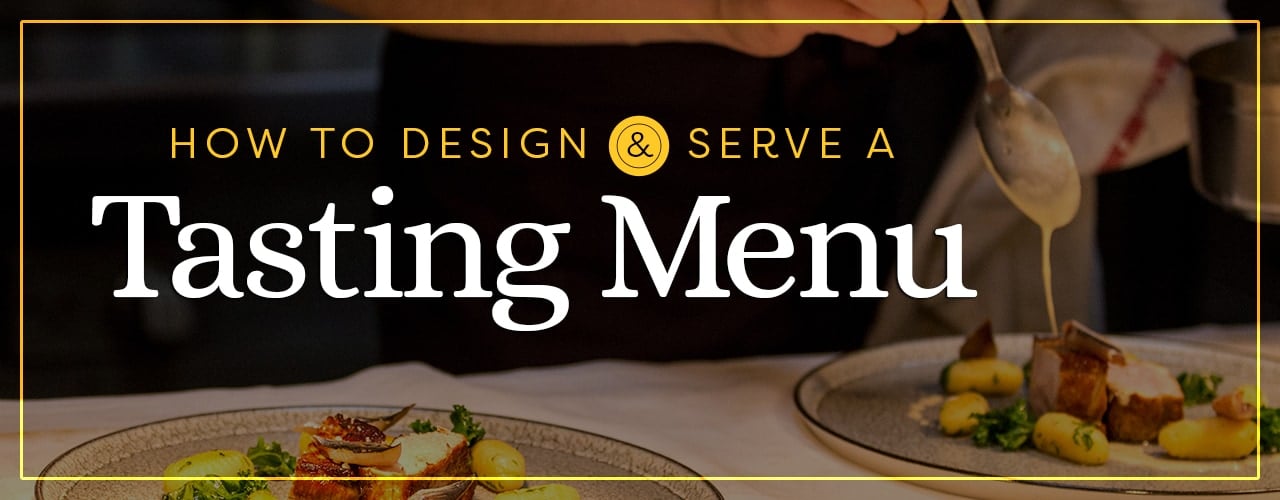What Is a Tasting Menu?
Last updated on Oct 30, 2020Jason KurtzHave you ever wondered how to highlight culinary art in your restaurant? If so, you might be interested in developing a tasting menu. Food lovers and critics are willing to travel to cities across the globe to experience the best a restaurant has to offer, and a tasting menu is the perfect way to highlight your signature dishes. Below, we've provided information on what a tasting menu is, the benefits of offering one in your restaurant, and everything you’ll need to know in order to create and serve one to your guests.
What Is a Tasting Menu?

A tasting menu, or degustation menu, consists of several bite-sized dishes that are served to guests as a single meal. They were inspired by the French term degustation, which is defined as the careful tasting of various foods with a focus on the senses and culinary art. The key distinction between a traditional menu and a tasting menu is that you aren't just paying for a meal, you're paying for an experience. In fact, many guests will order them for milestone events such as birthdays and anniversaries.
While a typical full course meal can include up to four courses, tasting menus can consist of eight, ten, or even twenty courses spread out over a longer period of time. In some cases, completing a tasting menu can take over three hours. Because of this, they require more attention than normal from your chef and staff, resulting in a higher price tag.
Benefits of a Tasting Menu
When executed correctly, there are many benefits that a tasting menu can bring to your restaurant. It's important to explore these possible benefits with your chef as you formulate your menu. Carefully plan out what you'll serve and how you'll serve it for the most effective experience.
- A tasting menu highlights the best of what your restaurant has to offer. During a typical dining experience, customers might only order one dish from the menu before leaving. Through a tasting menu, they can experience a variety of dishes from multiple parts of your menu.
- Smaller portion sizes help your chef express their creativity. They’ll have the opportunity to display their skills and ideas in ways they normally couldn’t.
- Tasting menus give your chef a chance to test out changes they might be considering for a current dish, or even prepare recipes that aren’t currently available on the menu!
Preparing a Tasting Menu
Creating a tasting menu involves more than choosing a few popular dishes and shrinking them down to bite-sized portions. It's essential to keep in mind that you aren't just putting together a meal, you're creating a culinary experience. Below, we'll examine the decisions you'll need to make in order to create an enjoyable and memorable tasting menu experience for your guests.
Deciding on the Menu
One of the most daunting tasks that comes with creating a tasting menu is deciding what to include on it. Choosing which dishes will appear on your menu can depend on a variety of factors, including the time of year, which ingredients are in season, and any themes you plan on using. For example, if you are creating a tasting menu in July, you might include dishes that feature traditional summer foods or center your menu around a summer theme.
Organizing the Menu

In addition to deciding how to organize your menu, determining the number of courses to include is essential to creating your tasting menu experience. Remember that there isn't a set amount of courses that need to be included in a tasting menu. While an established restaurant might consider including upwards of 10 courses throughout the tasting menu, smaller venues or menus developed to serve fewer people will likely include less.
Additionally, some tasting menus are served in homes rather than traditional restaurant settings. Wine tastings, beer tastings, and other food tastings are just a few popular tasting menus that are commonly held at people’s homes.
Choosing a Highlight
Deciding what meals to highlight is one of the most important parts of creating a tasting menu. This can vary based on your intentions for creating the menu. One common example is to highlight the skills and creativity of your chef, while another could be introducing your guests to new dishes you’d like to feature on your menu. If you’re hosting your own food tasting party, you might want to focus on broad appeal.
Serving a Tasting Menu

Once you’ve established what's going to be on your tasting menu and who you plan on serving it to, it’s time to focus on how you’ll present the food to your guests. Keep in mind that the focus of a tasting menu should be on the food itself. You'll want to make sure guests can enjoy each course with minimal interference from outside factors.
Tasting Menu Presentation
In order to invoke a sense of culinary art in each course, consider serving them on smaller, plain dishes. This will help your guests to focus on the look and texture of the food rather than the plates you serve them on. In addition, keep a variety of dining utensils ready so that your guests can enjoy the different dishes they’ll be served.
Offering Palate Cleansers
To ensure your guests fully enjoy each dish, consider offering a palate cleanser before each new dish arrives. They work to remove any aftertastes lingering in the mouth so that guests can enjoy each dish without continuing to taste the last. Palate cleansers are a key part of a tasting menu because each dish you serve can vary greatly from the one that came before it.
When choosing a palate cleanser, make sure to look for something with a fairly neutral flavor. Some commonly used palate cleansers include sparkling water, lightly brewed tea, celery sticks, and occasionally champagne.
Creating a tasting menu gives you the opportunity to highlight your strengths, creativity, and inspirations. What started as a luxury in 19th century France has grown into an experience for food lovers across the globe. If you’re looking for a new way to engage your guests and highlight culinary art, consider developing a tasting menu to serve in your restaurant or at your next food tasting party.



